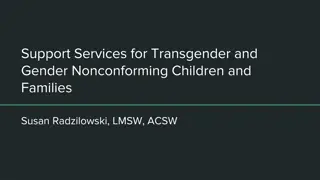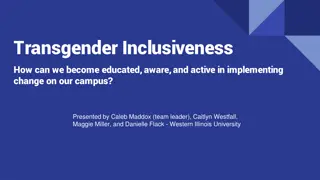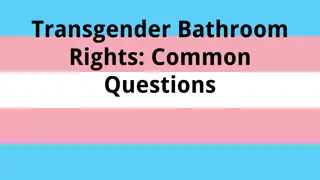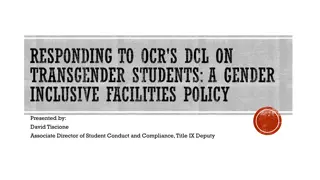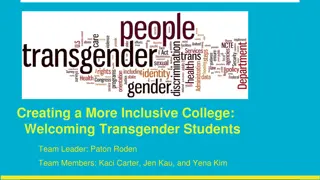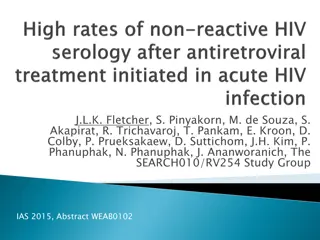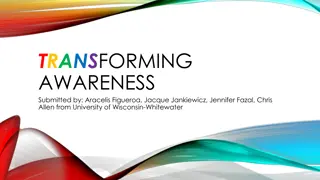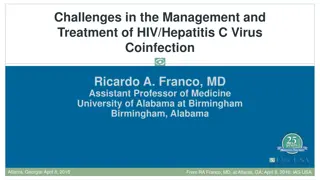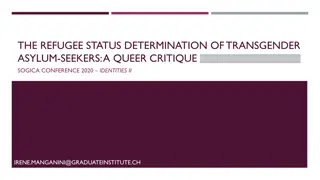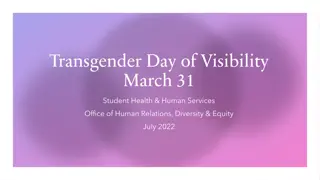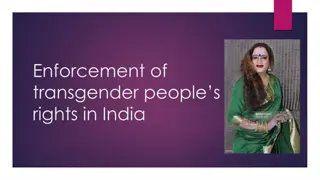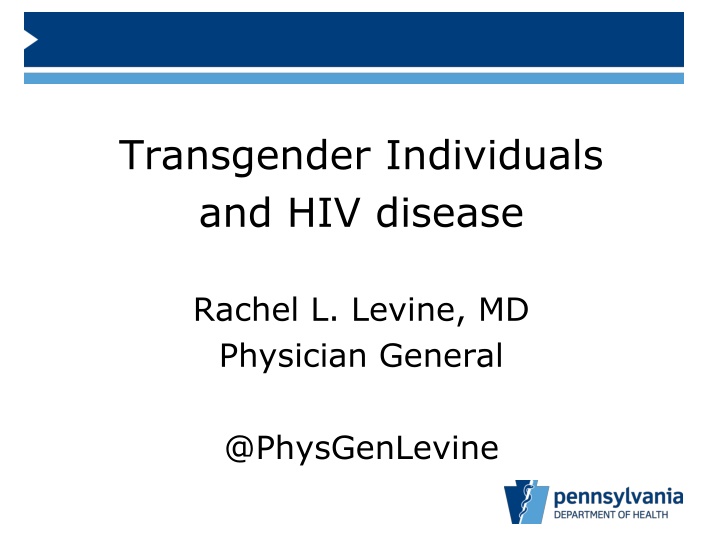
Transgender Individuals and HIV Disease Disparities
Learn about the disparities faced by transgender individuals in relation to HIV disease, stigma, discrimination, and health outcomes. Explore the concepts of gender identity, sexual orientation, and societal challenges that impact the transgender community. Discover the contributing causes of these disparities and the importance of addressing social determinants for LGBTQ individuals' health.
Download Presentation

Please find below an Image/Link to download the presentation.
The content on the website is provided AS IS for your information and personal use only. It may not be sold, licensed, or shared on other websites without obtaining consent from the author. If you encounter any issues during the download, it is possible that the publisher has removed the file from their server.
You are allowed to download the files provided on this website for personal or commercial use, subject to the condition that they are used lawfully. All files are the property of their respective owners.
The content on the website is provided AS IS for your information and personal use only. It may not be sold, licensed, or shared on other websites without obtaining consent from the author.
E N D
Presentation Transcript
Transgender Individuals and HIV disease Rachel L. Levine, MD Physician General @PhysGenLevine
Terms LGBTQQIAA+ Gender Roles Sexual Orientation Gender Identity and expression
Terms Difference between sexual orientation and gender identity Sexual orientation and gender identity are separate concepts, and it is important to understand both. A transgender person might consider themselves straight Sexual Orientation Gender Identity
Terms The difference between Sex and Gender Sex is the physical expression of genes. Gender is the concept of self perception and how one relates to another in society (masculine vs. feminine). The organic basis of gender identity may be a reflection of neurodevelopment of the brain.
Terms Transgender Describes people whose gender identity differs from their sex assigned at birth Cisgender A person who is not transgender
Terms Transgender spectrum Male-to-Female MTF - Transgender Women Female-to-Male FTM Transgender Man Crossdresser Transgender Transsexual Other terms Genderqueer, Gender Fluid, etc.
Disparities Stigma and Discrimination Transgender people experience very high rates of stigma and discrimination The National Transgender Discrimination Survey, 2011 found 55% had lost a job due to bias 51% harassed/bullied in school 61% victim of physical assault 64% victim of sexual assault 41% had suicide attempt (compared to 5.6 14.3% of US adults
Health Disparities Transgender individuals face particular disparities HIV/STDs up to 28% of transgender women test positive for HIV Victimization at least 21 transgender people were murdered in 2015 Suicide 41% had suicide attempt (compared to 5.6 14% of US adults) Are less likely to have health insurance than heterosexual or LGB individuals. 59% of avoided bathrooms out of fear Healthy People 2020
Contributing causes of disparity Contributing cause of disparity According to Healthy People 2020 the social determinants affecting the health of LGBT individuals are largely related to oppression and discrimination Legal discrimination in access to health insurance, employment, housing, marriage, adoption, and retirement benefits Lack of laws protecting against bullying in schools Lack of social programs targeted to and/or appropriate for LGBT youth, adults, and elders
Contributing causes of disparity Barriers to accessing health care Stigma, including outright refusal of care or inadequate care. Provider knowledge and training. Lack of health insurance, due to low employment rates and denial of marriage equality. Fear of talking with a doctor about sexuality or sexual health.
Disparities HIV Disease Men who have sex with men represent 2/3 of new HIV infections. Young people, ages 13-24, are 16% of US population but account for 26% of all new HIV infections. In 2009 newly identified HIV infection was 2.6% among transgender persons compared with 0.9% for cisgender males and 0.3% for cisgender women. It is estimated that 28% of transgender women test positive for HIV infection. One study found that 73% of transgender women who tested positive were unaware for their status.
Transgender people and HIV Transgender people and HIV Increased risk factors High-risk sex including sex work Injecting hormones without safe injecting practices Stress of social isolation can lead to increase substance use disorder Increased risk of violence, including intimate partner violence Barriers to treatment One study of people living with HIV in the USA found that only 59% of transgender patients, compared to 82% of those with a birth-assigned gender, were accessing ART Up to 73% of transgender women are unaware of status
HIV and opioid crisis Current opioid crisis puts PA at risk for increase HIV and HCV HIV outbreak in Indiana was linked to injection drug users In 2015, 3,505 drug-related overdose deaths were reported in PA, an increase of 30% from 2014
Heroin and Prescription Opioid Overdose Crisis Rate in urban county of Philadelphi a is 45.93 per 100,000 Rate in rural Cambria county is 42.52 per 100,000
Heroin and Prescription Opioid Overdose Crisis State s response is all-hands-on-desk Focus on prevention - Opioid stewardship Focus on Treatment including MAT at Centers of Excellence
PrEP Pre-Exposure Prophylaxis (PrEP) A daily pill to reduce risk of HIV Recommended for those HIV-negative and at very high risk of HIV infection In May 2014 US Public Health Service and CDE issued clinical practice guidelines
PEP Post-Exposure Prophylaxis (PEP) PEP involves taking anti-HIV medication as soon as possible after potential exposure Must be taken within 72 hours PEP is taken once or twice daily for 28 days
Transgender Medicine Transgender Medicine - In the Diagnostic and Statistical Manual of Mental Disorders (DSM-5), people whose gender at birth is contrary to the one they identify with will be diagnosed with Gender dysphoria. This diagnosis is a revision of DSM-IV s criteria for Gender identity disorder. Marked difference between the individual s expressed/experienced gender and the gender others would assign him or her, and it must continue for at least six months.
Transgender Medicine In children, the desire to be of the other gender must be present and verbalized. This condition causes clinically significant distress or impairment in social, occupational, or other important areas of functioning. The DSM-5 diagnosis adds a post-transition specifier for people who are living full-time as the desired gender (with or without legal sanction of the gender change).
Transgender Medicine Standard of Care The World Professional Association for Transgender Health, INC www.wpath.org New revision pending Evaluation and treatment of transsexual patients Psychological evaluation treatment Medical evaluation Hormonal therapy Surgical therapy
Transgender Medicine WPATH Standards of Care Eligibility criteria for hormonal gender reassignment. Demonstrate knowledge of what hormones can and cannot do and their social benefits and risks. A mental health evaluation is still a requirement for referral for hormone therapy. A period of psychotherapy is now recommended but not required. Recommended that patients live as the other gender for 12 months before genital surgery. Age considerations.
Transgender Medicine Treatment Reasons for hormone therapy Cross-sex hormonal treatments play an important role in the anatomical and psychological gender transition process. Hormones are often medically necessary for successful living in the new gender. They improve the quality of life and limit psychiatric co-morbidity, which often accompanies lack of treatment.
Transgender Medicine Hormone replacement therapy- HRT Male-to-Female (MTF) Anti-androgens Estrogens Female-to-Male (FTM) Androgens Benefits and side effects
Transgender Medicine Endocrine Treatment of Transsexual Persons: An Endocrine Society Clinical Practice Guideline, Hembree et al, J.Clinical Endocrinology and Metabolism, 9/2009, 94(9): 3132-3154 Establishes clinical guidelines for medical evaluation, hormonal treatment and follow-up of transsexual adolescents and adults. Accepted by the Endocrine Society, European Society of Endocrinology, WPATH and others.
Transgender Medicine Anti-Androgens: Block the production and effects of testosterone. Testosterone must be blocked for estrogen to work Use allows a lower dose of estrogen to be used to produce the same feminization but reduce the risks of estrogen. Many different kinds but many are expensive. Spironolactone- 100-300 mg.
Transgender Medicine Estrogens for MTF Estradiol (Estrace) 0.5 to 6.0mg. IM Estradiol Estradiol Transdermal (Fempatch, Alora, Climara, Estraderm, Vivelle Microdot) 0.1 to 0.2. Estrogel Topical compounded estradiol cream
Transgender Medicine Estrogen - Effects Skin Changes finer skin, thin nails Female fat distribution: Abdomen to breasts and hips Muscle changes-loss of 30% muscle mass Breast development max in two years (2/3 mothers size at age 21, older less development) Decrease hair loss, sometimes regrowth scalp hair Decreased body hair in two years (between breasts) Improvement in mood Heightened sensitivity to smell and color
Transgender Medicine Side Effects of Estrogen Excessive breast tenderness or discharge Pituitary tumors and Hyperprolactinemia Risk of thromboembolic events (particularly first year of HRT) High blood pressure secondary to fluid and salt retention Breast cancer Decreased libido, loss of erections, infertility (IMPOTENCE)
Transgender Medicine Testosterone for FTM Oral testosterone is metabolized in the gut and quickly inactivated in the liver. Usually given as an intramuscular injection. Testosterone cypionate 100-200 mg. IM q 2 weeks. IM shots interval may cause some mood fluctuations and a change in the interval of dosing can help this. Topical- Androgel, Testosterone Creams
Transgender Medicine Changes on testosterone in FTM First changes are deepening of the voice in about 1-3 months Periods cease within 1-2 months (titration) with IM shots- Cream takes 6-8 months Muscle mass increases about 30%, reduces fat and redistributes fat to male pattern Facial hair develops in 6-24 months and may take five years to maximize. Highly individual results Male pattern balding can develop Acne can develops Clitoral enlargement Fertility Issues
Transgender Medicine Trans Teens There are the issues of puberty which can be devastating to a MTF trans-teen with changes of facial hair, changes in stature and bone structure, as well as deepening of the voice. In the young FTM, the onset of menses and breast development can also be terrifying and depressing. The incidence of suicidal thought and depression is very high particularly if there is not good family support.
Transgender Medicine Standards of care (age less than 18) Recommends no medical treatment for prepubertal children with Gender Dysphoria. Adolescents are eligible for medical treatment if they meet the following criteria: Fulfill DSM criteria for Gender Dysphoria At least Tanner Stage 2 No serious psychiatric co-morbidity that interferes with treatment Have adequate support during treatment Demonstrate understanding of the treatment
Transgender Medicine Standards of care (age less than 18) Protocol developed in the Netherlands Hormonal treatment should be conducted in two phases: Initial Phase MTF Pubertal Blocker FTM Pubertal Blocker Second Phase MTF may be given estrogenic agents FTM may be given masculinizing doses of androgens
Transgender Medicine Trans-Teens Follow-up Protocols established Usually no surgery before age 18 There are exceptions based on individual cases
Transgender Medicine Gender Confirmation Surgery Previously called Sexual reassignment surgery MTF FTM FFS- Facial Feminization surgery Changes in dose of hormones Don t Assume all patients want surgery!
Creating welcoming practice for LGBTQ patients Avoid Assumptions Don t Assume All patients are heterosexual All patients use traditional labels Sexual orientation or gender identity based on appearance That a patients sexual orientation or gender identity is only a phase Sexual behavior or gender identity hasn t changed since last visit The Fenway Institute
Creating welcoming practice for LGBTQ patients Taking a history of sexual health Ironically, it may require greater intimacy to discuss sex than to engage in it. The Hidden Epidemic Institute of Medicine, 1997 Use inclusive and neutral language Who are you attracted to? Are you in a relationship? Don t make assumptions about sexual activities Don t make assumptions about reproductive goals
Creating welcoming practice for LGBTQ patients The Clinician s Role Assist patients in healthy discovery, autonomy, and self-acceptance. Make the clinical environment safe, accessible, and welcoming to LGBT patients. Importance of education about LGBT issues for nurses and ALL staff
Creating welcoming practice for LGBTQ patients The Clinician s Role Create an open and honest dialogue Ask non-judgmental questions about sexuality, sexual identity, and gender identity of all patients. Respect confidentiality while working with patients to find sources of support at home or in their community. Be prepared with referrals and resources.
Questions??? QUESTIONS? @PhysGenLevine


